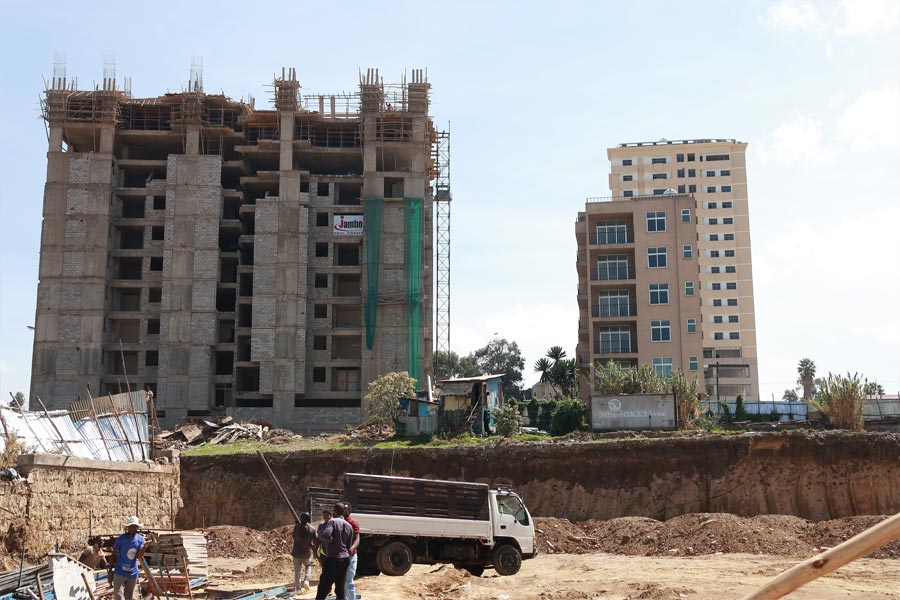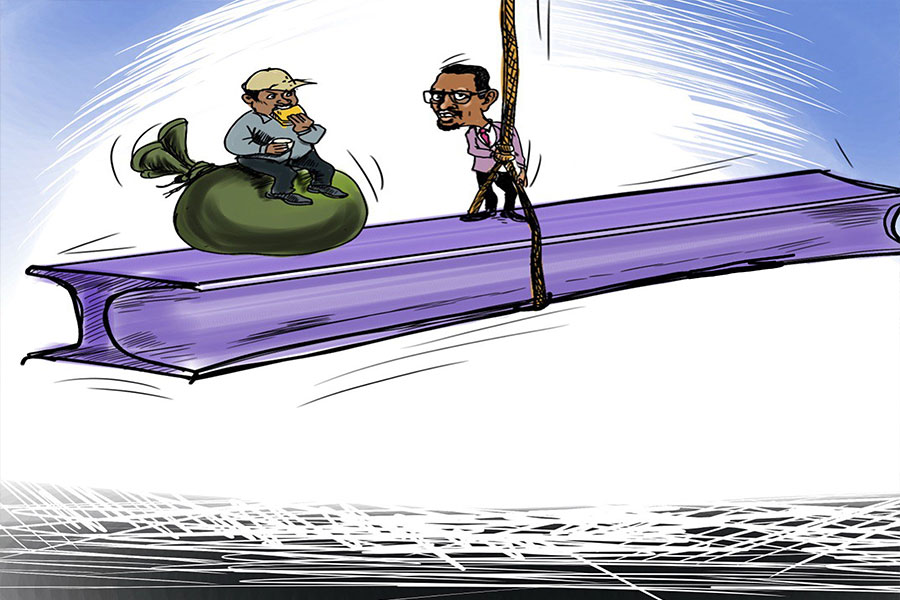
Commentaries | May 13,2023
Jul 15 , 2023
By MUNIR SHEMSU ( FORTUNE STAFF WRITER )
Alarming levels of food insecurity in Ethiopia expose an untenable situation. A report the United Nations (UN) released last week is a disquieting reminder of the pervasive issue of hunger where approximately 70 million people are plagued by inconsistent access to meals, and over 25 million people go by days without food.
The report, authored by Marco V. Sánchez Cantillo and José Rosero Moncayo, was commissioned as part of the "The State of Food Security & Nutrition in the World 2023". A collaborative effort by the Food & Agriculture Organization (FAO), the World Food Program (WFP), International Fund for Agricultural Development (IFAD), and the World Health Organisation (WHO), the series examines urbanisation, agrifood systems transformation, and healthy diets on a global scale.
In Ethiopia, the data paints a bleak picture.
A startling 83pc of the population cannot afford a balanced, nutritious diet, which costs approximately 3.7 dollars a day on average. This struggle for food security is especially ironic given that 63pc of the average per capita income of 3.85 dollars is spent on food, positioning Ethiopia among the countries with high food budgeting.
The country's economic outlook has been rocked by surging inflation rates, oscillating above 30pc for the past year, and soaring to a dramatic 43pc high for food in May 2022.
However, Prime Minister Abiy Ahmed (PhD) recently touted an increase in per capita income surpassing the 1,000 dollars milestone under his administration. Yet, this economic marker falls woefully short in covering the cost of a healthy diet — one that provides a balanced mix of unprocessed or minimally processed foods across different food groups, crucial for preventing health issues such as stunting, wasting, and micronutrient deficiency.
Ethiopia's children under the age of five are among the world population suffering greatly from stunting (148 million) and wasting (45 million), representing a tragic 34pc and 6.2pc, respectively.
Despite the improved economic indicators, the country ranks among the top countries with malnourished populations.
Renowned nutritionist, Zelalem Debebe (MD), noted the long-standing impact of malnutrition on Ethiopian children. She noted that a child needs a consistent and rich diet after the age of six months — a basic necessity that is scarce in many parts of the country.
"Rural mothers struggle to prepare a meal a day," she told Fortune.
According to her, stunting has lifelong consequences, inhibiting the complete development of both physical and mental capacities in individuals. The combination of illiteracy and an underdeveloped culinary culture significantly affects the diversity and quality of diets.
The issue of food insecurity is not confined to Ethiopia but spreads across the globe, with nearly 2.4 billion people, mostly women and inhabitants of rural areas, lacking year-round access to safe, nutritious, and sufficient food. Consequently, the rate of hunger has escalated across Africa, Western Asia, and the Caribbean, accompanied by rampant malnutrition, the report revealed.
According to the report, the number of people who experienced hunger globally in the past year exceeded 790 million, an increase of 122 million from pre-COVID-19 pandemic levels. The number of people facing hunger in Africa has surged by over 57 million since the outbreak of the pandemic.
Adding to this complicated global dynamic is the war between Russia and Ukraine, which has led to food import bills skyrocketing to a record-breaking two trillion dollars in March 2022. Both countries contribute significantly to the global output of barley, wheat, and maise. Russia’s role as a major exporter of fertiliser further escalated the issue, impacting nearly one in four people in Africa and contributing to severe food insecurity this year.
These global and national figures on rising hunger contradict the narrative spun by Ethiopia's officials, who claim that the country has achieved self-sufficiency in wheat production and has become a net exporter.
The rapid urbanisation process, with projections indicating that nearly seven in 10 people will reside in cities by 2050, is dramatically reshaping agrifood systems. Regions experiencing the highest rates of urbanisation, such as sub-Saharan Africa and South East Asia, face daunting challenges regarding poverty, food insecurity, and access to affordable healthy diets.
Urbanisation does not always lead to economic growth. Instead, it often stimulates atypical trends like migration from rural regions and population growth, exacerbating urban poverty. The report cites Ethiopia's Sidama Regional State as an example, where food insecurity compels households to dispatch an adult member to metropolitan cities in search of better opportunities.
Agricultural economist Shimelis Araya (PhD) emphasised that understanding food insecurity requires context. Its meaning varies greatly across different regions and societies. He pointed out that Ethiopia exhibits unique urbanisation patterns, leading to increased agricultural productivity in areas adjacent to cities, despite the pervasive food insecurity and poverty.
The UN report's revelation that only 17pc of Ethiopians can afford a healthy diet, while 25 million face severe food insecurity, is not surprising to Shimelis, however.
"It is to be expected," Shimelis told Fortune.
The rising fertiliser prices, growing conflicts, and the surge in urbanisation, which transforms fertile lands into construction sites, are key factors behind the grave scenario.
As the global community strives to meet the Sustainable Development Goals (SDGs) by 2030, escalating conflicts, economic downturns, and frequent extreme weather events present an increasingly challenging path ahead. The report highlighted that without an urgent, coordinated response from international organisations, national governments, and civil society, the world is poised to fall woefully short of achieving the goal of zero hunger.
PUBLISHED ON
Jul 15,2023 [ VOL
24 , NO
1211]

Commentaries | May 13,2023

Sunday with Eden | Jul 08,2023

Sunday with Eden | Nov 05,2022

Commentaries | Dec 30,2023

Commentaries | Oct 05,2019

Radar | Apr 02,2022

Radar | Feb 27,2021

Fortune News | Mar 16,2019

My Opinion | Mar 11,2023

Viewpoints | Feb 03,2024

Feb 24 , 2024 . By MUNIR SHEMSU
Abel Yeshitila, a real estate developer with a 12-year track record, finds himself unable to sell homes in his latest venture. Despite slash...

Feb 10 , 2024 . By MUNIR SHEMSU
In his last week's address to Parliament, Prime Minister Abiy Ahmed (PhD) painted a picture of an economy...

Jan 7 , 2024
In the realm of international finance and diplomacy, few cities hold the distinction that Addis Abeba doe...

Sep 30 , 2023 . By AKSAH ITALO
On a chilly morning outside Ke'Geberew Market, Yeshi Chane, a 35-year-old mother cradling her seven-month-old baby, stands amidst the throng...

Apr 20 , 2024
In a departure from its traditionally opaque practices, the National Bank of Ethiopia...

Apr 13 , 2024
In the hushed corridors of the legislative house on Lorenzo Te'azaz Road (Arat Kilo)...

Apr 6 , 2024
In a rather unsettling turn of events, the state-owned Commercial Bank of Ethiopia (C...

Mar 30 , 2024
Ethiopian authorities find themselves at a crossroads in the shadow of a global econo...